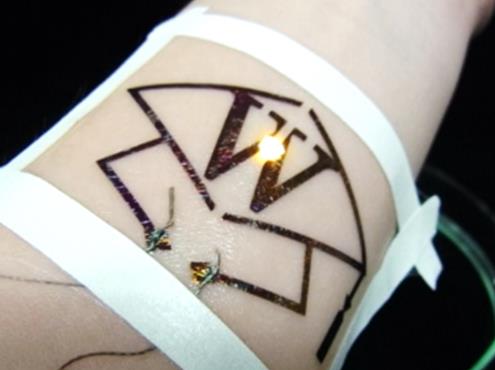Waseda team produces innovation for ultra-conformable “electronic tattoos”
Fri, Feb 24, 2017-
Tags
Improved polymer and new assembly method uses household inkjet printer to create 750 nm-thin nanosheet devices without soldering

Black lines are simply printed on the nanosheet, but are able to conduct electricity
Waseda University researchers have developed processes and materials for ultrathin stick-on electronic devices using elastomeric “nanosheet” film, achieving ease of production while also preserving high elasticity and flexibility fifty times better than previously reported polymer nanosheets.
This research is published in the Journal of Materials Chemistry C online edition, February 1, 2017.
Smart electronics and wearable devices have several requirements for widespread adoption, especially ease of fabrication and wearing comfort. The materials and processes developed by the Waseda University team represent huge strides forward in both criteria.
Inkjet printing of circuitry and low-temperature fixing allow production of electronic devices which are durable and functional but also extremely thin and flexible enough for use as a comfortable, skin-fitting appliance, while also maintaining the easy handling properties and protection of elastomeric films. At only 750 nm (120 times thinner than a human hair), the new film is ultra-thin and flexible. These advances could help change the nature of wearable electronics from objects like wristwatches to items less noticeable than a band-aid.
The Waseda team also established a method of joining electronic components without soldering, allowing thinner and more flexible elastomer films (SBS: polystyrene-polybutadiene-polystyrene). Conductive “wiring” is created by inkjet printing, which can be done with a household type printer without the need for clean room conditions. Further, conductive lines and elements such as chips and LEDs are connected by adhesive sandwiching between two elastomeric nanosheets, without using chemical bonding by soldering or special conductive adhesives.
Thanks to the simple, low-temperature processes, the resulting ultrathin structures achieve better adhesion, without using adhesive matter such as tape or glue, better elasticity and comfort for skin-contact applications. The new system was proven functional for several days on an artificial skin model.
These results were achieved through collaboration among three specialties: Molecular assembly and biomaterials science; medical robotics and rehabilitation engineering; and micro-electromechanical systems, thanks to collaborative structures at Waseda University.
Uses for these products are expected to include human-machine interfaces and sensors in the form of electronic tattoos, as radically improved tools for the fields of medicine, healthcare and sports training.
These applications are the subject of further investigation by the Waseda University Institute of Advanced Active Aging Research.
* * *
Title: Sandwich fixation of electronic elements using free-standing elastomeric nanosheets for low-temperature device processes
Authors: Marin Okamoto, Mizuho Kurotobi, Shinji Takeoka, Junki Sugano, Eiji Iwase, Hiroyasu Iwata and Toshinori Fujie
Journal: Journal of Materials Chemistry C
DOI:10.1039/c6tc04469g













